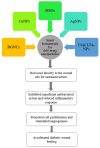Construction of Smart Biomaterials for Promoting Diabetic Wound Healing
- PMID: 36770776
- PMCID: PMC9920261
- DOI: 10.3390/molecules28031110
Construction of Smart Biomaterials for Promoting Diabetic Wound Healing
Abstract
Diabetes mellitus is a complicated metabolic disease that has become one of the fastest-growing health crises in modern society. Diabetic patients may suffer from various complications, and diabetic foot is one of them. It can lead to increased rates of lower-extremity amputation and mortality, even seriously threatening the life and health of patients. Because its healing process is affected by various factors, its management and treatment are very challenging. To address these problems, smart biomaterials have been developed to expedite diabetic wound closure and improve treatment outcomes. This review begins with a discussion of the basic mechanisms of wound recovery and the limitations of current dressings used for diabetic wound healing. Then, the categories and characteristics of the smart biomaterial scaffolds, which can be utilized as a delivery system for drugs with anti-inflammatory activity, bioactive agency, and antibacterial nanoparticles for diabetic wound treatment were described. In addition, it can act as a responsive system to the stimulus of the pH, reactive oxygen species, and glucose concentration from the wound microenvironment. These results show that smart biomaterials have an enormous perspective for the treatment of diabetic wounds in all stages of healing. Finally, the advantages of the construction of smart biomaterials are summarized, and possible new strategies for the clinical management of diabetic wounds are proposed.
Keywords: biological dressings; diabetic foot; hydrogel; regenerative medicine; tissue engineering; wound healing.
Conflict of interest statement
The authors declare no conflict of interest.
Figures






References
Publication types
MeSH terms
Substances
Grants and funding
LinkOut - more resources
Full Text Sources
Medical

